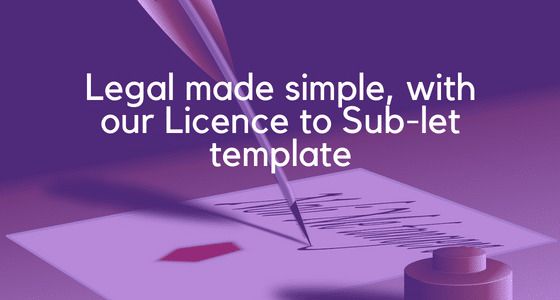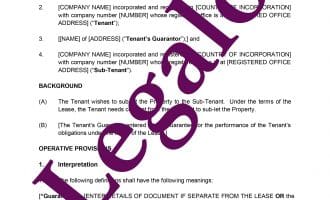Licence to Sub-Let
Our Licence to Sub-Let template:
- Drafted by a UK legal specialist
- Easy to customise to your requirements
- Affordable legal peace of mind
- Our drafting notes provide step-by-step guidance

How Does It Work?
-
1. Download
-
2. Edit
-
3. Print
-
4. Sign
This is our Licence to Sub-Let template. David, our experienced in-house solicitor and co-founder, drafted this template. This template can be used when a commercial landlord agrees to grant permission to their tenant to sub-let the leased commercial property. As it is designed for commercial property in England and Wales, it should not be used for property in Scotland. Property law is quite different in Scotland.

Using our Licence to Sub-Let template
You can download the template in Word format, then you can easily edit it to meet your specific requirements, and then save it. It should not take you long. With the guide that comes with the template when you buy it, you will find the whole process easy.
When using a template to create your own property agreement for your business, it is important to make sure that both parties are in agreement. If they are not, then you should obtain professional advice from a solicitor.
We have drafted our document in a generic format that enables you to customise it. With our free guide as to how to complete it, you will find this process quick and easy. Preview the guide here: guide to our licence to sub-let agreement template.
When to use this Licence to Sub-Let template
A landlord of commercial property should use this template when its tenant wants to sub-let the whole of it. As the template includes optional wording, it works whether or not:
1. a guarantor currently guarantees the tenant’s duties in the lease; or
2. there is “security of tenure” when the sub-lease expires (i.e. a right to renew it).
Our guide to the Sub-Lease Agreement Template, which is a full guide to the template, includes guidance on security of tenure. We have available the declarations and notices to contract out of the right for the tenant to renew the lease. They are separate and free of charge.
You should put in place a legally binding licence to sub-let whenever you as a landlord consent to a specific letting of the property or part of it by your tenant. The licence requires that the tenant puts in place a sub-lease in a form of which you approve. This then ensures that you can make provision for protection and remedy in the event of issues arising with the sub-tenant of the property.
Discount package available
If you need the full batch of documents for the sub-letting of a lease, we offer 20% off when you buy them all at the same time using our discount package. Click here for more details.
If you would like to see our other commercial property templates, click on the link.

FAQs on the Licence to Sub-let
Below, we have answered the top questions from the Internet about licences to sub-let, mainly in the context of a commercial lease.
Do you need a licence to sub-let?
In the UK, if a commercial tenant wants to sub-let all or part of their rented property, they would almost always need to get their landlord’s written consent, often referred to as a ‘Licence to Sub-let’. Technically it depends on the lease, but leases nearly always have a term requiring consent. If the tenant were to sub-let without this permission, it would likely be a breach of the lease and may result in consequences, such as eviction (i.e. forfeiture of the lease). This is why tenants must check their commercial lease before sub-letting.
What is a licence to sub-let in the UK?
In the UK, a licence to sub-let is the document signed by the landlord to give permission to the tenant to sub-let all or part of their rented property. It is a legally-binding agreement that grants the landlord’s permission for the existing tenant to sub-let all or part of the property.
Can you legally sub-let in the UK?
You can legally sub-let in the UK as long as a licence to sub-let has been obtained from the landlord if required by the terms of the lease. This ensures that the landlord has given proper consent for a tenant to rent out all or part of their commercial unit to another party, while also outlining certain conditions to which the tenant must adhere. Sub-letting without this licence may be a breach of the lease, as the landlord may not be aware of another party using their property.
Can licensees sub-let?
The ability for licensees to sub-let depends on the terms specified in the licensing agreement. Generally, licensees have limited rights and may not have the authority to grant a further sub-let without the licensor’s (and landlord’s) permission. It is essential to check the specific terms and conditions outlined in the licence agreement, as they vary and may restrict or permit letting activities. In most cases, letting by licensees would require written consent from the licensor and landlord.
How do I start sub-letting in the UK?
Before you start letting a leased commercial property, you should review your commercial lease and check:
- if the terms allow sub-letting, and
- if so, whether the landlord’s consent is required.
If you do need to get your landlord’s permission, then this should be obtained in the form of a written licence to sub-let. This licence ensure that:
- you can conclude the letting process by way of a sub-lease with your chosen licensee; and
- you will not be in breach of contract.
Draft a legal agreement with your licensee outlining all terms and conditions of the arrangement.
Do I need permission to sub-let a room?
As we have said above, generally your lease will oblige you to obtain your landlord’s permission to sub-let part of your commercial unit. So you would need your landlord’s permission to sub-let a room for the letting not to be a breach of contract. Failure to obtain this permission can lead to a breach of your lease, eviction (forfeiture), or other legal consequences. So always:
- check your lease’s terms before making changes, and
- communicate with your landlord to ensure compliance with the terms when letting your leased unit.
Can I sub-let a property I own?
If you own a property on a freehold basis, then you would not be “sub-letting” it, as such. This is because yours would be the first letting of it. If you own it on the basis of a long lease, as is more common with residential property, then this would be sub-letting. This basis of ownership is rare with commercial property. Normally sub-letting of a long residential lease does not require the landlord’s consent, but for a commercial property it might. However, if you have a mortgage, you should review that document to ensure you have the right to sub-let without your bank’s consent. The bank might charge a higher interest rate if you let out your residential property.
What are the benefits of sub-letting?
There are several benefits to renting excess space out:
- Rental income: Sub-letting allows you to generate income by renting out a part of your commercial unit.
- Flexibility: It can provide flexibility in the case of your having spare space in your unit.
- Cost-sharing: Sub-letters may share utilities and other expenses, saving you money during the arrangement.
- Occupancy: This can help ensure your unit doesn’t sit vacant.
- Helping others: It can offer affordable commercial space to small businesses.
What happens if you get caught sub-letting in the UK?
If the landlord catches you sub-letting in the UK without its written consent, you may face serious consequences. These can include:
- eviction, i.e. early termination of your tenancy agreement (known as forfeiture); and
- potential legal action for damage caused.
The landlord can also claim any profits made from the unauthorised letting. This is why it’s essential to:
- obtain proper permission; and
- adhere to the terms of your commercial lease to avoid these consequences.
Why is sub-letting illegal in the UK?
Sub-letting is not inherently illegal in the UK. However, it may be in breach of contract if done without the landlord’s written consent. Commercial leases typically require this consent, and unauthorised letting can breach the terms of the agreement, potentially leading to eviction. This is why a licence to sub-let is so important. It makes sure that your landlord’s authorisation is down in writing, making your letting legally sound.


